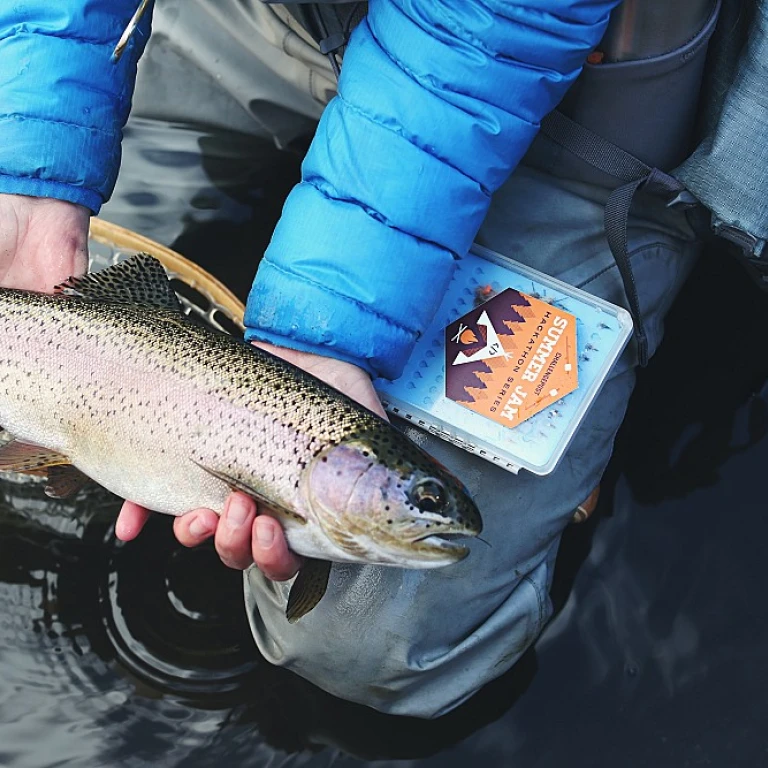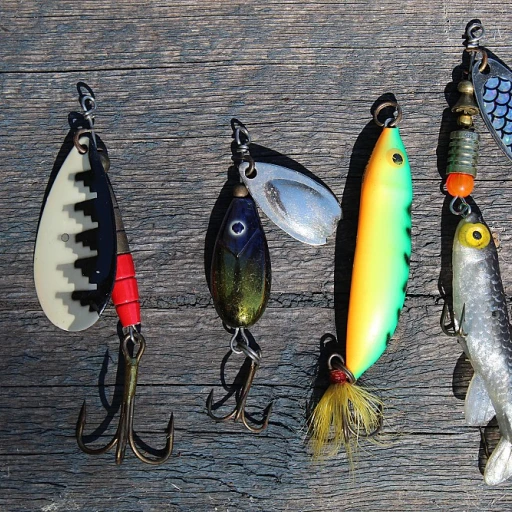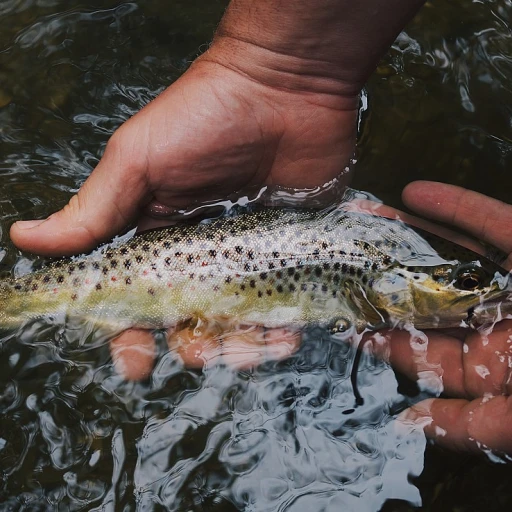The rise of Alabama bass
How Alabama bass found its way to prominence
Imagine reeling in a bass only to discover it’s not the kind you expected! That’s what happened to many anglers in the southeastern U.S. The Alabama bass, known scientifically as Micropterus henshalli, has rapidly shifted the balance of fish populations in numerous lakes and reservoirs. Back in 1976, the Alabama bass made a splashy entrance by being introduced to non-native waters, intentionally or otherwise. Now they’re pretty much everywhere in regions like Tennessee, North Carolina, and even Georgia. Their spread wasn’t just random; anglers, seeking a more challenging and aggressive fish, often transported Alabama bass across states. Surprisingly, these fish aren’t just a nuisance. They're a testament to innovation in the bass fishing community aiming for sport fishing highs. But on the flip side, these introductions have permanently altered the ecosystems. Mainly in Lake Norman, where the native species find themselves struggling to compete. Read more about how atmospheric changes can influence your fishing expeditions here. Statistics show some alarming trends related to Alabama bass populations. For instance, within a decade, these fish took over more than 50% of the population in the Tennessee reservoirs, pushing aside the beloved smallmouth and largemouth bass species. The North Carolina Wildlife Resources Commission in 2020 noted a worrying decline in native fish counts by over 30% since the Alabama bass introduction. Major experts such as Dr. Mike Allen from the University of Florida highlight the ecological threat posed by these fish. “The Alabama bass’s aggressive nature and high adaptability often leads to rapid displacement of native species,” states Dr. Allen. Their prominence ignites fiery debates in the fishing world. Enthusiasts argue over ethical considerations—should anglers continue introducing the Alabama bass, knowing the potential ecological damage? There’s no denying that Alabama bass have left an indelible mark.Understanding the Alabama bass species
Delving into the Alabama bass species
With its distinctive streaked pattern and aggressive behavior, the Alabama bass (Micropterus henshalli) is a fascinating species in the bass family. They often get confused with the spotted bass, but experts like Gene Gilliland, the B.A.S.S. Conservation Director, emphasize the critical differences. 'The Alabama bass are genetically distinct and exhibit different growth and behavioral patterns compared to other bass species,' says Gilliland (B.A.S.S. Conservation, 2022).
Known for their adaptability, Alabama bass can live in a variety of environments, from the clear, freshwater lakes of North Carolina to the diverse river systems in Georgia. Their range has seen a steady increase over the last few decades. According to a study conducted by Graham (2015) from the University of Georgia, the introduction and spread of the Alabama bass began in the 1970s, which has expanded to several reservoirs outside their native habitat.
Physical and behavioral traits
Alabama bass are medium-sized, typically reaching around 14 to 17 inches in length but can grow larger under ideal conditions. One remarkable trait is their striking lateral lines making them easy to distinguish from the largemouth bass. They prefer cooler, deep waters and are often found in rocky habitats where they hunt for smaller fish, crayfish, and insects.
The Alabama bass also display intense territorial behaviors, often overtaking habitats from native species such as the smallmouth bass and largemouth bass populations. This aggressive nature has caused shifts in the local aquatic ecosystems leading to significant changes in local fish populations (Maceina et al., 2016).
Reproductive habits
A critical aspect of the Alabama bass's biology is its reproductive strategy. These fish are early spawners, usually beginning their breeding cycle when water temperatures reach around 60°F. A single female can produce thousands of eggs, which she lays in hidden nests guarded fiercely by males. This high reproduction rate contributes to their rapid population growth and the subsequent competitive pressure on native species.
Alabama bass thrive in both large reservoirs and small tributaries. An example can be found in Lake Norman, North Carolina, where the population has surged since their introduction in the early 2000s. This has led anglers to favor these lakes as new top fishing spots, although it comes with its set of management challenges (North Carolina Wildlife Resources Commission, 2017).
Impact on native fish populations
Effects on other bass species
Alabama bass (\u003cem\u003eMicropterus henshalli\u003c/em\u003e) have brought significant changes to local ecosystems, especially for other bass species like largemouth bass, smallmouth bass, and spotted bass. These bass, native to different regions, find themselves competing with the Alabama bass for resources.
Overlapping habitats
The introduction of Alabama bass to waters where other black bass species already exist has led to overlapping habitats. For instance, in reservoirs like Lake Norman in North Carolina, the introduction of Alabama bass has caused considerable shifts in the structure and dynamics of fish populations. Alabama bass tend to outcompete native species for food and breeding grounds.
Hybridization concerns
A major issue arising from the spread of Alabama bass is hybridization. According to a study published in the \u003cem\u003eNorth American Journal of Fisheries Management\u003c/em\u003e, hybridization between Alabama bass and native species like spotted bass and smallmouth bass is increasingly common, raising concerns among fisheries managers. This genetic mixing can lead to the decline of pure native species, altering the original fish population balance.
Predation pressures
Another impact is increased predation pressures. Alabama bass are known for their aggressive nature, and their presence often results in higher predation rates on native fish species, including juveniles of largemouth and smallmouth bass. This heightened predation directly affects the recruitment rates of these native populations, potentially leading to long-term declines.
Recreational fishing adjustments
For anglers, the rise of Alabama bass has meant adjusting their fishing techniques and expectations. Anglers targeting largemouth or smallmouth bass often find themselves pulling in Alabama bass instead, which, while offering a different set of challenges and rewards, can be frustrating for those with specific fishing goals.
Management efforts
Experts like Dr. Steve Sammons from Auburn University have been vocal about the need for effective management strategies. Dr. Sammons emphasizes that public awareness and strict regulations are crucial in preventing the unwanted spread of Alabama bass. This includes measures like controlling the transfer of fish from one body of water to another by boaters and anglers.
`}```The role of anglers in managing Alabama bass
Anglers' influence on Alabama bass management
Managing Alabama bass isn’t just the job of biologists and fishery managers; anglers play a critical role. A considerable number of anglers target Alabama bass because of their fighting spirit and fairly accessible opportunities in many southeastern lakes and rivers. But this popularity comes with both benefits and challenges for managing their populations. Bass anglers, thanks to their passion and dedication, have been instrumental in data collection efforts. By reporting their catches, tagging releases, and participating in surveys, they provide critical information on Alabama bass populations. For example, in North Carolina, a significant portion of data on bass populations comes from angler-reported catches. This collaborative approach enables fishery managers to better understand population dynamics and to make informed decisions on regulations and conservation practices.Environmental advocacy and responsible fishing
Anglers can also be advocates for the environments they enjoy. Prominent voices in the fishing community, such as professional angler Mike Iaconelli, advocate for responsible fishing practices. They stress the importance of catch-and-release techniques that minimize stress and damage to the fish. This is especially crucial for Alabama bass, which have interbred with other species in some areas, creating hybrids that can complicate management efforts. Educating the fishing public about the potential consequences of introducing Alabama bass into new water bodies is another area where anglers shine. The Alabama Bass Trail, for example, is more than just a series of competitive events. It’s an educational platform that promotes sustainable fishing practices and highlights the importance of preserving native fish populations while enjoying the sport.Regulations, rules, and the angler's role
Regulations play a vital role in Alabama bass management, with rules varying from state to state. In Alabama and Georgia, for instance, size limits and bag limits are enforced to maintain healthy populations. It is common for anglers to be directly involved in lobbying for these regulations, often pushing for stricter controls to ensure long-term sustainability. However, compliance with these regulations is critical. The introduction of Alabama bass into non-native waters, often done illegally by uninformed anglers, poses a risk to local fish species. In Tennessee, for example, the introduction of Alabama bass into reservoirs originally designed for smallmouth bass has led to significant ecological changes. These instances showcase the need for constant education and strict enforcement of fishing regulations. In conclusion, anglers are not just active participants in catching Alabama bass; they are integral to the species' management and conservation. Their roles in data provision, environmental advocacy, and adherence to regulations shape the future of this species across southeastern waters. Together with fishery managers and biologists, they form a dynamic team aimed at balancing the joy of fishing with the need to protect and preserve our aquatic ecosystems.Case study: Lake Norman
Alabama bass at lake norman: a localized phenomenon
lake norman, stretching across north carolina, provides a unique and telling example of the impact alabama bass have on local fish populations. The introduction of this bass species was never officially sanctioned, and yet, it has thrived, showcasing both the adaptability of the fish and the often unintended consequences of human interference. Interestingly, the growth of alabama bass populations has coincided with a decline in other, native species such as the smallmouth and largemouth bass.
Why did the alabama bass flourish here? lake norman offers a rich, varied habitat which supports multiple bass species, and the alabama bass found its niche quickly. Their introduction led to noticeable shifts in the lake's ecosystem, where the aggressive nature of the alabama bass placed significant pressure on native species for resources.
Competition and survival: a fish-eat-fish world
The bass population dynamics in lake norman became a classic case of survival of the fittest. Alabama bass, known scientifically as Micropterus henshalli, competed fiercely with the largemouth and smallmouth bass for food and territory. Studies indicate about a 40% decline in smallmouth bass populations since the alabama bass's introduction. This shift can be particularly harsh for anglers who historically targeted smallmouth bass, seeing their prized catches dwindle.
Responses from local anglers
In north carolina, fishery management, including the actions of commercial and recreational anglers, plays a big role. In lake norman, bass anglers have had to adjust their strategies and expectations. Some have turned their focus entirely to the more prolific alabama bass, while others advocate actively managing the bass populations through culling or relocation efforts.
One local angler, John Fisher, says, "I used to come here every weekend for the smallmouth, but these days, I’m more likely to reel in an alabama bass. It’s definitely not what it used to be, and that messes with a lot of our routines." Simply put, local anglers' perceptions and behaviors directly influence fish populations and can either exacerbate or mitigate the impact of species such as the alabama bass.
Mitigation efforts and future outlook
State wildlife agencies, in concert with local conservation groups, are keeping a close eye on the situation at lake norman. There have been efforts to boost native fish populations through breeding programs and habitat restoration. Despite this, the sheer adaptability of the alabama bass underscores a greater, ongoing challenge in fisheries management.
Ultimately, dealing with the rise of the alabama bass at lake norman involves balancing human recreation with ecological preservation. Although efforts are underway, it remains a complex issue with no simple solutions.
"It’s a constant tug-of-war," notes biologist Dr. Rachel Thompson. "We’re learning as we go, but one thing is clear: To control alabama bass effectively, we all need to work together, from biologists to local fishermen."
Controversies and debates
Clashes over conservation and recreational fishing
The story of Alabama bass, or Micropterus henshalli as it's scientifically known, is not without its share of controversy. Introduced across lakes like Lake Norman and beyond, these bass have ignited debates in the fishing community, particularly among anglers and conservationists.Spreading like wildfire
Introductions of Alabama bass into non-native waters have caused significant turmoil. In reservoirs across Alabama, North Carolina, and Georgia, they've swiftly established themselves, often at the expense of native species. Surveys by the North Carolina Wildlife Resources Commission indicate that in some lakes, such as Lake Norman, Alabama bass have almost completely displaced native species like largemouth bass and smallmouth bass.
Competition and hybridization
The introduction and subsequent spread of these fish has led to increased competition with native black bass species. According to a 2020 study published in Fisheries Research, hybridization between Alabama bass and native species, such as largemouth and smallmouth bass, can reduce the purity of the native gene pool, leading to complex genetic challenges.
Economic versus ecological impact
The debate also extends to the economic impact of these fish. Anglers from around the country flock to fisheries known for having robust Alabama bass populations, such as those along the Alabama Bass Trail. This influx boosts local economies but also pressures conservation groups who view the species as a threat to native environments.
case study: the silver lining
However, not all outcomes are negative. For example, Lake Norman has seen a rise in trophy-sized Alabama bass, creating a unique niche for bass fishing tournaments. Professional angler Mike Iaconelli stated in an interview, "Alabama bass have brought a new dynamic to our fishing tournaments. While they have outcompeted some species, they’ve also brought more attention and tourism to the lakes they inhabit."
future directions for management
What remains crucial is finding a balance. Effective management strategies, as suggested by the American Fisheries Society, involve continuous monitoring and strict regulations on the transport and stocking of Alabama bass. Local fisheries management and proactive measures are necessary to keep Alabama bass from causing further ecological imbalance while maintaining the positive economic aspects they bring.
There's no denying the intricate dance between maintaining ecological integrity and supporting recreational fishing economies. The ongoing debate over Alabama bass highlights the complexity and importance of making informed, balanced decisions regarding our waterways.
Expert insights on Alabama bass management
Insights from leading experts on Alabama bass management
To understand the impact of Alabama bass on local ecosystems, we need guidance from specialists who live and breathe fishery science. One such expert is Dr. David G. Coughlan, a leading ichthyologist with extensive experience studying black bass species, including Alabama bass (Micropterus henshalli).Dr. Coughlan shares that the introduction of Alabama bass to new habitats has had mixed results. 'On one hand, Alabama bass can adapt to various water bodies, enhancing regional biodiversity,' he says. 'However, their aggressive nature often leads to conflicts with native populations like smallmouth bass, drastically altering local ecosystems.'
Another critical insight comes from Jessica Heitz, a fishery biologist working with the North Carolina Wildlife Resources Commission. Her team conducted a detailed study on Lake Norman, documenting the behavioral traits of Alabama bass. According to Heitz, 'We observed that Alabama bass aggressively compete for resources, leading to the displacement of native species. In specific scenarios, this has caused a significant shift in the fish community structure.'
In terms of tackling these challenges, Kenneth Parker, a renowned conservationist from Tennessee, emphasizes community involvement. 'Anglers play a crucial role in controlling Alabama bass populations. Catch-and-release practices could exacerbate the issue, so targeted harvesting in overpopulated regions can be effective,' he suggests.
Parker also advocates for more public awareness. He highlights that many anglers unknowingly contribute to the spread of Alabama bass by relocating their catches from one water body to another. 'Education campaigns focusing on the consequences of such actions can help mitigate these impacts,' Parker believes.
Relevant case studies expose the necessity for nuanced management strategies. An example is Lake Gaston, where a strategic approach combining education, regulation, and active angler participation led to a more balanced fishery. Monitoring and tracking Alabama bass populations also provide real-time data to make informed decisions.
Ongoing research is exploring innovative solutions, including the potential use of selective breeding to create less aggressive hybrid species that might coexist more harmoniously with native populations. Even so, Dr. Coughlan reminds us, 'There's no silver bullet—effective management requires an adaptive and multidisciplinary approach.'
In conclusion, the introduction and management of Alabama bass present complex challenges. Continuous collaboration between scientists, conservationists, and the angling community will be crucial to safeguarding local ecosystems while enjoying the excitement and sport that these resilient fish bring.
" }
Future of Alabama bass in local ecosystems
Projection of Alabama bass in future ecosystems
Looking ahead, the presence of Alabama bass (Micropterus henshalli) in various waterways across the United States poses both challenges and opportunities for managing bass populations and local ecosystems. Dr. Matthew Thomas, a renowned fisheries biologist from Auburn University, emphasizes the need for continuous research and adaptive management strategies to mitigate any adverse effects.
One significant concern is the potential competition Alabama bass introduce to other native fish species. For instance, studies have shown that this subspecies can outcompete native largemouth bass and smallmouth bass, leading to shifts in local fish population dynamics. In Lake Norman, North Carolina, the introduction of Alabama bass has led to notable changes in the distribution of native black bass species, compelling local fishery managers to rethink their conservation practices.
Moreover, in some Southern states like Georgia, Alabama, and Tennessee, there's an ongoing debate about whether Alabama bass should be managed as an invasive species or as an asset to sport fisheries. While some anglers appreciate the harder fight Alabama bass offer, biologists are wary of their expansion into non-native habitats. A fascinating point of reference is the management strategies along the Tennessee River, where different sections of the waterway see varied impacts of this species introduction.
Overall, the future management of Alabama bass will require a nuanced approach, balancing between preserving native ecosystems and catering to the interests of recreational fishers. As Tom Benson, President of the Alabama Bass Association, points out, “Our goal is to create a sustainable and enjoyable fishing environment for all, and that means carefully managing the interaction between different bass species.”
Amateur and professional anglers alike will play a crucial role in the future trajectory of Alabama bass populations. Through responsible fishing practices, support for ongoing research, and participation in conservation efforts, the fishing community can help ensure the health and viability of diverse aquatic systems.


-large-teaser.webp)
-large-teaser.webp)


-large-teaser.webp)






